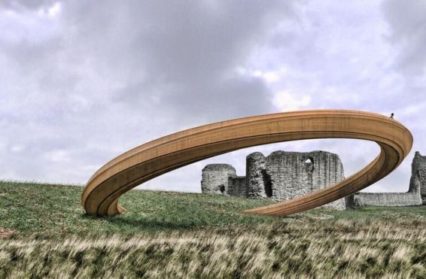Adam Somerset follows on from his initial article on the proposed Iron Ring public art in Flint.
The Flint Ring died on July 26th. The Western Mail, a subsidiary of a City PLC, did a cut-and-paste summary. BBC Wales is unlikely to show much interest into the underlying issues.
My first article on the subject brought to light some issues that look as pertinent as ever. The statement from the Arts Council of Wales revealed that the Tourist Board (now Visit Wales) sits at the top table of decision-making on the arts. This has long been evident. This is not to denigrate the objectives of that organisation, but to repeat that the values of tourism and art are in conflict. There is no guarantee that the tourist interest has been banned from the counsels of artistic decision-making. Indeed its presence looks undiminished.
The conversations in cyberspace on the Flint Ring-Thing were discursive and as usual extended to the witty, the scabrous and the scatological. I have no patience with small minorities hijacking the decisions of government. This is in part experience of the opposite of government, my visits in youth to a country in times of lull between bouts of civil war. I no more like cyber-mobs than I do militias with guns.
But what was revealing about this exchange was the difference between the parties. Officialdom offered a master-class in how not to deal with an emergency. The committee fractured into its component organisations and could only offer unattributable assertion. The Arts Council put out “The selection panel consisted of one member from Arts Council of Wales and other members representing Visit Wales and Cadw.” In other words, “we made the decision but it wasn’t us, guv.”
Against organisational anonymity real voices and real names spoke. Gary Owen, Sharon Morgan, Cerys Matthews: these and others are names that have rendered service to the arts.
For the Minister the crisis erupted from nowhere. That is the nature of politics. The government will be hopping mad at its quangos creating a side issue when so much else that matters is on the agenda. The loser here is the Arts Council of Wales. Public arts subsidy has only one goal, that is excellence in art. To miss the meaning of the ring as metaphor displays an ignorance of art and history that runs deep.
If I return to Meredydd Barker again it is only because he is unique in Wales, and probably in the United Kingdom, in being a dramatist with a background in the plastic arts. His drama, Two Princes, is uncannily prophetic, a rebuttal to those who claim theatre to be ephemeral. “People who can create public art on this scale are as rare as film directors who can do epic,” he writes; “It’s an uncommon talent. Anthony Gormley, to pick an easy example, would not have been this insensitive. He just wouldn’t.”
Government is saying nothing but it looks as though artists and citizenry were excluded from consultation or involvement. This is not the only occasion when power in Cardiff has looked first to London rather than to its own country.
This is the second cultural storm of the season. I never make predictions but I can see an inevitability in the source of the next. Its timing is not imminent but I can make a strong guess that the men on the boards and committees of power have learned nothing.











